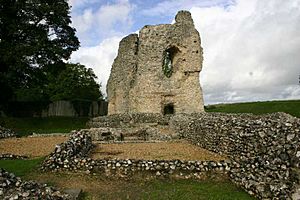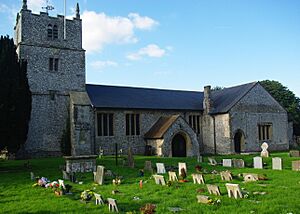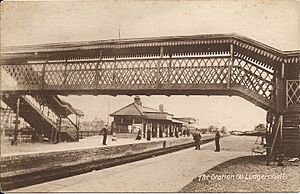Ludgershall, Wiltshire facts for kids
Quick facts for kids Ludgershall |
|
|---|---|
 Ludgershall Castle |
|
| Population | 5,390 (2021 Census) |
| OS grid reference | SU265508 |
| Civil parish |
|
| Unitary authority |
|
| Shire county | |
| Region | |
| Country | England |
| Sovereign state | United Kingdom |
| Post town | ANDOVER |
| Postcode district | SP11 |
| Dialling code | 01264 |
| Police | Wiltshire |
| Fire | Wiltshire |
| Ambulance | Great Western |
| EU Parliament | South West England |
| UK Parliament |
|
| Website | Town Council |
Ludgershall is a town in Wiltshire, England. It's about 16 miles (26 km) northeast of Salisbury. The town is located on the A342 road, which connects Devizes and Andover. Ludgershall is also a civil parish, which means it's a local government area. The parish includes a nearby area called Faberstown and a small village called Biddesden.
Contents
History of Ludgershall
People have lived in the Ludgershall area for a very long time. There is proof of settlements from the late Bronze Age or early Iron Age at Windmill Down.
Early Settlements
The Domesday Book of 1086 was a big survey ordered by William the Conqueror. It recorded small settlements at Ludgershall and Biddesden. The entry for "Litlegarsele" (Ludgershall) showed it was a small farming area. The name "Litlegarsele" likely means "small grazing area" or "little grass heath."
After Ludgershall Castle was built in the late 1000s, the village grew around it. It became a medieval borough. Ludgershall was on an important road between Marlborough and Winchester in the 1200s. However, the village later became less important. A fire in 1679 caused damage. Some of the oldest buildings still standing are the Queen's Head pub and cottages on Castle Street.
Military Presence
Since around 1898, Windmill Hill has been part of the Salisbury Plain Training Area. This is a large area used by the Army. More land in the west of the parish has been used by the Army since 1939. Military activities, like building Tidworth Camp nearby, caused the town's population to grow a lot.
Faberstown
In the early 1900s, a local politician named Walter Faber started building houses east of Ludgershall. This new area became known as Faberstown. By 1970, Ludgershall and Faberstown had grown together, almost like one village. In 1992, Faberstown officially became part of Wiltshire.
Biddesden Hamlet
Biddesden is a small village east of Ludgershall. You can reach it by going through Faberstown. Most of Biddesden is in Wiltshire. However, a small part, including the site of a Roman Villa, is in Hampshire.
Important Buildings and Structures
Ludgershall has several interesting historical buildings and structures.
Ludgershall Castle
Empress Maud once found safety in Ludgershall Castle in 1141. She was escaping from King Stephen's army. She managed to get away by pretending to be a dead body. The castle was home to many important people and even royalty over the years. The village of Ludgershall grew up around the castle.
King Henry III later turned the castle into a hunting lodge. But by the 1400s, it was no longer used. Today, English Heritage looks after the castle ruins. You can still see three large walls and earthworks.
Ludgershall Cross
In the town centre, you can find the remains of a Medieval preaching cross. This cross dates back to the 1300s, during the time of King Edward III. English Heritage also cares for this cross. It was put back up in the early 1800s in the old market place.
The cross is about 12 feet tall. In 1897, an iron fence was built around it to celebrate Queen Victoria's Diamond Jubilee. The cross has carvings on its four sides, but they are very worn. People believe the carvings showed:
- The Ascension of Jesus (North side)
- The Three Marys (South side)
- The Crucifixion of Jesus (East side)
- The Command to Saint Paul (West side)
St James' Parish Church
There has been a church in Ludgershall since the 1100s. The parish church of St James has parts from the 1100s, like a blocked doorway and a north window. The church has been changed and repaired many times over the centuries. In 1873, major restoration work was done.
The church tower has six bells, with two of them dating back to the 1600s. The building is considered a very important historical building. Inside, you can see a font from the 1400s. There is also a large monument to Richard Brydges (1500–1588) and his family.
Biddesden House
Biddesden House is a large, historic house. It is now home to a special farm that raises Arabian Horses. The current building was built between 1711 and 1712. It is also a very important listed building.
Corunna Barracks
During the Second World War, Army depots were built near Ludgershall. The US Army used one of these depots in 1943 to get vehicles ready for the invasion of Europe. These barracks were home to the 26 Engineer Regiment of the Royal Engineers until 2015. They were then taken down to build new homes for military families.
Railway History
Ludgershall railway station opened in 1882. It was part of the Midland and South Western Junction Railway. This railway connected places like Cheltenham and Southampton. In 1901, a special railway line was built from Ludgershall to serve Tidworth Camp. This line opened to the public in 1902. Another short line was added in 1943 to serve the military depot in Ludgershall.
Ludgershall station closed to passengers in 1961. The line north to Swindon also closed. The line to Tidworth closed in 1963. However, the railway line from Ludgershall south to Andover, England is still open. The Army uses it to move tanks and other equipment to and from the depot and to the Salisbury Plain Training Area. There is a level crossing on Tidworth Road where the railway crosses the road.
Some local groups are working to get the railway line between Ludgershall and Andover reopened for passenger trains.
Media and News
Local news and TV shows for Ludgershall come from BBC South and ITV Meridian. You can get TV signals from either the Hannington or Rowridge TV transmitters.
The town is served by local radio stations like BBC Radio Wiltshire and BBC Radio Berkshire. Other radio stations include Greatest Hits Radio Salisbury and Castledown FM, which is a local community station.
Local newspapers that cover Ludgershall are the Salisbury Journal and the Andover Advertiser.
County Confusion
Many people mistakenly think that Ludgershall is in Hampshire, not Wiltshire. This is because its postal code (SP11) and phone code (01264) are both linked to Andover, which is in Hampshire.
Ludgershall Today
Ludgershall has grown a lot in recent years. It is now an important town with many successful businesses and a good amount of housing. Part of the old Army depot site has become Castledown Business Park. The town has good facilities for entertainment and shopping. There are two pubs, social clubs, small independent shops, and two supermarket chains.
Ludgershall has several schools. There is Ludgershall Castle Primary School, which was built in 1965. There is also a secondary school called The Wellington Academy, which opened in 2011. A second primary school, Wellington Eagles, opened in 2020.
See also
 In Spanish: Ludgershall para niños
In Spanish: Ludgershall para niños





